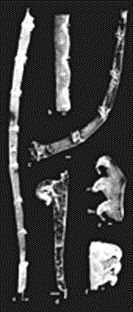Song Ca Fm
Type Locality and Naming
The Song Ca Fm was described without stratotype (Dovjikov A.E. et al. 1965). Other authors have described it, but its stratotype had not been designated. Among the Suoi Dam, Huoi Kho, Huoi Hang and Huoi Thu sections described by Nguyen Van Hoanh (in Nguyen Van Hoanh et al 1978) the Huoi Thu section (N= 19°23’, E= 104°16’) can be selected as lectostratotype of the Song Ca Fm.
In the work of Vu Khuc, Bui Phu My et al. (1990) the Song Ca Fm, dated as O-S, corresponds to the lower part of the Song Ca Fm and lower part of the unit Undifferentiated Middle Paleozoic described in (Dovjikov A.E. et al. 1965), to the Suoi Mai Fm of Le Duy Bach (1969) and the lower part of Song Ca Fm of Tran Van Tri et al. (1977).
Synonym: Série du haut Song Ca: Fromaget J. 1928 (S-D). Hệ tầng Sông Cà: Mareichev A.M., Trần Đức Lương in Dovjikov A. E. và nnk.. 1965 (PZ 5 c); Trần Văn Trị và nnk. 1977 (S-D); Nguyễn Văn Hoành và nnk. 1978 (O3-S1); Phạm Kim Ngân, Lương Hồng Hược, Phạm Đình Long 1986 (O3-S1); Vũ Khúc, Bùi Phú Mỹ và «»£.1990) (O-S sc)\ Phạm Kim Ngân và nnk. 1994 (O3-S); Tống Duy Thanh, Vù Khúc và nnk. 1995 (O3-S), Trần Toàn và nnk. 1998 (O 3-S1). Phức hệ Sông Cả: Tống Duy Thanh, Nguyễn Đức Khoa in Vũ Khúc và nnk. 2000 (O3-S)
Lithology and Thickness
Huoi Thu stratotype, 2320 m thick, is: (1) Quartz-mica schist, quartzite sandstone, interbedded with siltstone, 470 m. (2) Polymictic sandstone, quartz-sericite schist, and in the uppermost part, clayey limestone; 850 m. (3) Gritstone, shale, sandstone and siltstone, 1000 m thick, containing Early Silurian graptolites.
Relationships and Distribution
Lower contact
Its lower boundary has not been observed.
Upper contact
The Song Ca Fm rests conformably under the Tay Trang Fm (= "Huoi Nhi Fm")
Regional extent
The Song Ca Fm occurs in two main bands; the first extends from Muong Xen, Tuong Duong to Quy Chau, Nghe An Province, the south Song Ca River band - from the Vietnamese-Laotian border west through Nghe An to Ky Anh, Ha Tinh Province.
GeoJSON
Fossils
Some Silurian spores occur also in the formation, such as Zonosphaeridium sp., Leiotrichoid.es sp.
[Figure: Sông Cả Fm (O3-S2 sc): Silurian: Graptolites Monoclimacis vomerina, Pristiograptus kweichihensis (images courtesy of Prof. Ta Hoa Phuong, Vietnam Natl. Univ. Hanoi)]
Age
Depositional setting
Additional Information
